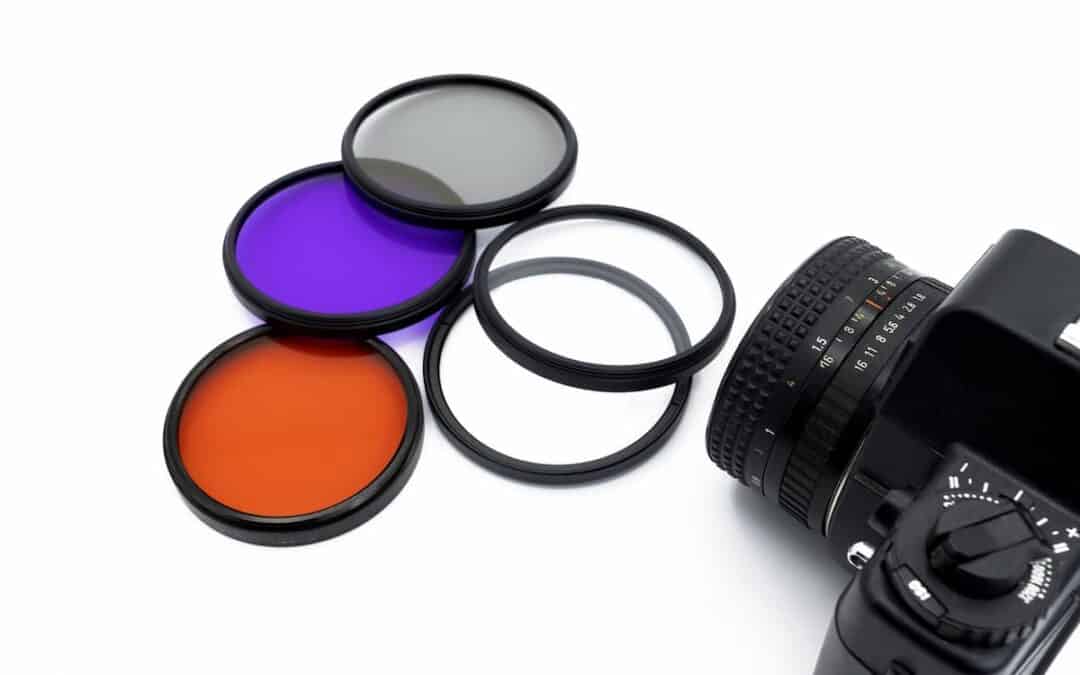Whether you’re a professional photographer or just getting started with a new hobby, you’ve probably heard of camera lens filters before. What you may not know is just how many kinds of filters there are or the purpose of each one. Two of the most common kinds of lens filters are UV filters and polarizers or polarizing filters.
A UV lens filter absorbs UV light and reduces the UV rays that enter the camera to reflect more true-to-life color, whereas a polarizer absorbs all light and eliminates glare. Both filters absorb light, but of different kinds and with different purposes.
The rest of this article further explains these filters and their purpose. We’ll describe some other kinds of lens filters and when to use them and answer other common questions about lens filters. Keep reading if you’re ready to take your photography skills up a notch!
Table of Contents
What Are the Differences Between a UV Lens Filter and a Polarizer?
A UV filter reduces how much UV light enters the camera while a polarizing filter absorbs all light, not just UV. So, UV filters are meant to reduce light while polarizing filters are meant to maximize the absorbed light.
The primary difference between these two filters is that a UV filter only reduces the amount of UV light entering your camera. In contrast, a polarizer, or a polarizing filter, absorbs all light that would get reflected away from the lens if the filter wasn’t there.
UV filters make pictures of faraway subjects clearer, and for this reason, they are occasionally called “haze” filters. This filter is the best way to get true-to-life color because it reduces the blue cast that UV rays cause.
UV filters can also act as protection for your lens against any elements you might come into contact with: dust, dirt, grease, moisture, and more. Buying a new lens filter is significantly cheaper than buying a new lens, so the filter should take most of this damage instead of the lens itself.
On the other hand, polarizing filters absorb all light, including some UV light. If you’re trying to take a picture of a body of water, for example, a polarizer would absorb the light reflecting off the water. If glare is a glaring issue in your photography (pardon the pun), a polarizer is a great filter to use.
When using a polarizer, photographers can see beyond any glare to focus on their subject and take a better shot. They’ll also get more aesthetically pleasing photos, especially if they are photographing a landscape.
All About UV Lens Filters
The UV lens filter is one of the oldest filters created for camera lenses. This filter reduces how much ultraviolet light that passes into a camera. This function is particularly important when shooting film photography because the film is more sensitive to the effects of UV light than digital cameras are.
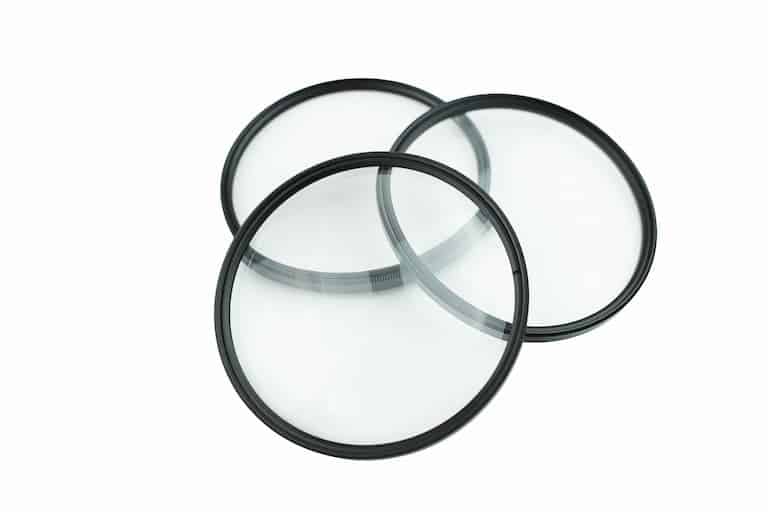
However, many photographers still choose to put a UV filter on their camera lens to protect it from outside elements, such as dirt, dust, moisture, and other grime.
Without a UV lens filter, you may notice discoloration in your photos, especially a blue tint. This blue hue is caused by ultraviolet light. This is less of an issue with contemporary DSLR and mirrorless cameras, but it used to be a big problem back when there was only film photography. Nowadays, UV filters are primarily used as lens protection, though UV absorption is still somewhat useful.
If you choose to use a UV filter as protection, keep in mind that it can’t protect your lens from all damage. They typically make UV filters with weak glass, so they break easily, and then your lens is susceptible to damage. Additionally, a UV filter cannot protect against internal damage at all.
They’re effective against scratches and environmental hazards, though, so it’s worthwhile and useful to have one for protective purposes.
Another thing to keep in mind about UV filters is that they can slightly reduce your image quality. A lens is another layer that light needs to go through to make an image, and this process reduces the resolution of a picture. However, this reduction in quality is so small that it is largely unnoticeable or easily fixed in the editing process.
How much a filter reduces the quality of your photo also depends on the quality of your filter. As with most other camera equipment, you get what you pay for. A cheap lens filter is more likely to distort your image in a noticeable way than a pricier one.
We recommend the Hoya 72mm Screw-In Filter from Amazon.com for a high-quality UV filter. This filter has high-quality protective coatings, so your camera lens will be shielded well, and it has good light transmission, so your image will still be high quality and without vignetting. It’s also compatible with wide-angle lenses.
If you’d like a more budget-friendly option, the Waka MC UV Filter is available on Amazon for a very affordable price. This filter comes in various thread sizes, so you’ll most likely be able to find one that is compatible with your lens. It has a 16 layer multi-coating and is backed by a two-year warranty.
Ultra Slim 16 Layers Multi-Coated Ultraviolet Protection Lens Filter for Canon, Nikon, and Sony DSLR Camera Lenses.
When To Use a UV Filter
Here are some situations where it may be useful to have a UV filter on your camera lens:
- You often shoot events or large groups of people. If you’re around a lot of people with an expensive camera lens, you’re asking for trouble. It’s all too easy for a person to run into a photographer and cause them to drop their lens, spill a drink on the lens, or otherwise damage it. If you’re often in situations where an accident could happen, having an extra layer of protection on your camera lens isn’t a bad idea.
- Your camera lens is often exposed to environmental hazards. If you’re a nature or wildlife photographer or a sports photographer that often shoots outside, the protective function of a UV lens filter is essential.
- You have children and often take pictures of them. We all want great pictures of our kids! However, kids can be grabby, and their grubby fingers can leave fingerprints and smudges on a camera lens that are difficult to clean off. Filters are much easier to wipe clean.
- You have a really expensive camera lens. Camera lenses can be crazy expensive, so if you spent a pretty penny on yours, you’ll want to do everything you can to protect it.
- You’re shooting with film. Digital cameras don’t necessarily need a UV filter anymore, but film is more susceptible to the effects of UV light. Those using film will get more use out of the UV filter’s absorption function than digital camera users.
- You’re prone to accidents. You know who you are—some people are just more likely to damage their camera lens than others. If that’s you, it’s better to add an extra layer of protection. Better be safe than sorry!
When Not To Use a UV Filter
Here are some situations where you probably don’t need a UV filter:
- You take most of your photographs inside a controlled studio. If you don’t have the risk of accidents or damage from environmental hazards, you probably won’t get much protection from your UV filter. You’ll just have to be careful not to smudge your camera lens.
- You shoot in situations that have bright lights on a dark background. Using a UV filter in this situation will most likely create ghosting, which is when light repeatedly reflects off the surface of a lens and is then visible in the image.
- You don’t want to edit your image. If you want your photo to be complete without any editing, you shouldn’t use a UV filter to avoid the slight reduction in quality that can occur when using a filter.
- You’re using a different filter. Stacking filters will reduce the quality of your image, so if you’re using another filter, you shouldn’t use a UV filter in addition to the other one. You’re more likely to have some vignetting in the final image if you do stack filters.
Whether or not to use a UV filter depends on the photographer, their subjects, the environment, and the priorities of the shoot.
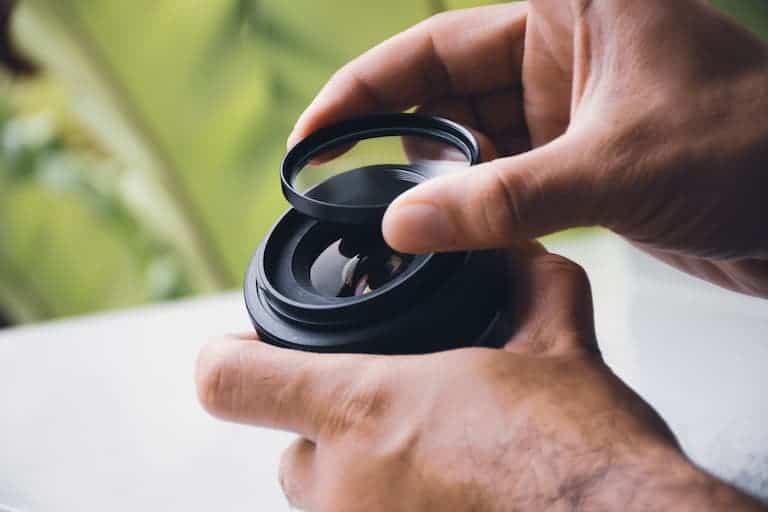
Pros and Cons of Using a UV Filter
Beyond needs, each filter comes with a unique set of pros and cons. Here are the advantages and disadvantages of UV lens filters:
Pros
- Protects your lens from environmental hazards and scratches.
- Removes blue hues from ultraviolet light.
- Produces more accurate colors in photographs.
- Relatively inexpensive.
- Easy to clean.
- Easy to replace.
Cons
- Breaks easily.
- Most modern digital cameras don’t need a filter to block UV light, so the primary function of a UV filter is somewhat useless.
- Slightly reduces image quality.
Being knowledgeable about the advantages and disadvantages of these filters can help you decide whether or not you need one.
All About Polarizers
Polarizers, or polarizing filters, are great tools for photographers who want to block light waves and create a clearer and more vivid image. This filter reduces reflections and haze in pictures while increasing the color saturation.
Polarizing filters cut through the haze that results from light waves hitting particles in the air. These particles decrease visibility and reduce the saturation of colors in pictures, so using a filter that reduces this haze also makes colors more vibrant.
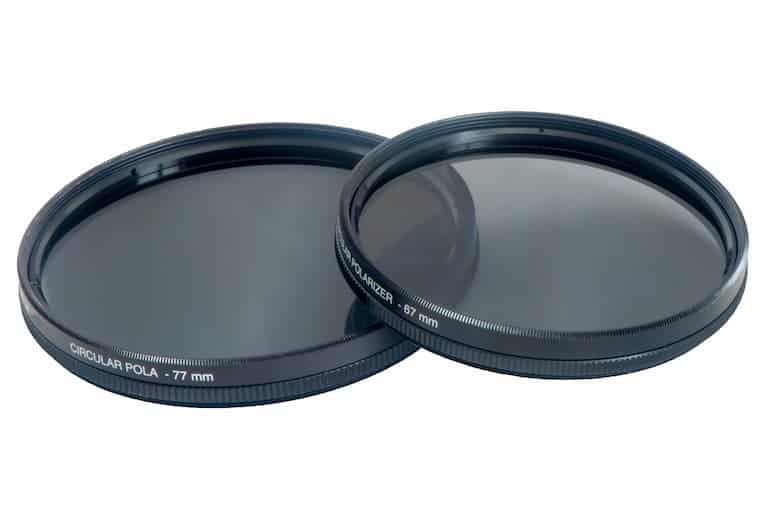
There are two kinds of polarizing filters: linear and circular. Linear polarizing filters have one polarizing layer and are typically not used by professional photographers because they’re known to cause autofocus issues. Circular polarizers (CPL) have two polarizing layers, so the autofocus issues are avoided.
Polarizers also come in different shapes. The most common shape is a circle, and once it’s attached to the lens front, it can be rotated to increase or decrease the polarization effect. Some polarizers are rectangular, but these are becoming less common. Finally, some manufacturers make polarizers that are specifically shaped for a particular filter holder.
My favorite polarizing filter is the Nikon Circular Polarizer II Filter, available on Amazon. This filter is made with high-quality, multi-coated glass. Additionally, the front filter element is easily rotatable to change the amount of polarization, making it easy to control which reflections are and aren’t present in your image. Though the filter is made by Nikon, it’s also compatible with several non-Nikon lenses.
The Hoya Alpha Circular Polarizer Filter from Amazon is a great choice if you’re on a tight budget. This filter provides great optical quality at a more affordable price. It’s made with precision-milled aluminum and comes in various sizes, so you can surely find one that’s compatible with your lens.
When To Use Polarizing Filters
Here are some situations where using a polarizing filter would be a good idea:
- You’re a landscape photographer. Have you ever tried to take a picture of a stunning landscape and been disappointed with the results? This is common because sunlight is bouncing all over the atmosphere and objects that are in a landscape, which can cause photographs to look dull and the colors not as bright as they appear in real life. A polarizer cuts out reflected light, which enhances the saturation and contrast.
- You’re shooting in bright light conditions. The brightness of sunlight can wash out photographs. Using a polarizer will help you get deeper and more saturated colors.
- You’re photographing water. Polarizers can help you see through shallow water because it excludes the light that reflects from the water’s surface. This creates an interesting and appealing photo.
- Clouds are in your image. Polarizers bring definition to clouds that make them much more attractive in photos than they would otherwise appear.
When Not To Use Polarizing Filters
Here are some situations where you may not benefit from a polarizing filter:
- You’re using an extreme wide-angle or a fisheye lens. These lenses cover a wide field of view, and as a result, a lot of sky and using a polarizer can result in different shades of blue in the sky.
- You’re shooting a panorama or images you want to stitch together to make a panorama. It is impossible to get the same polarization effect every time you take a photo, so if you’re planning on stitching images together, the sky will look different in each one. This is difficult to fix in post-production.
- You’re shooting in low-light conditions. Polarizers reduce the amount of light entering your lens, which you do not want in low-light situations. You’ll need all the light you can get, so definitely don’t use a polarizer.
- You like taking pictures of rainbows. Rainbows are reflected light, so if you try to take a picture of one with a polarizing filter on your lens, it’ll disappear.
The benefits of polarizing filters are great, but you shouldn’t use polarizers all the time. Knowing when and when not to put on your filter is a great way to get the best photos you can.
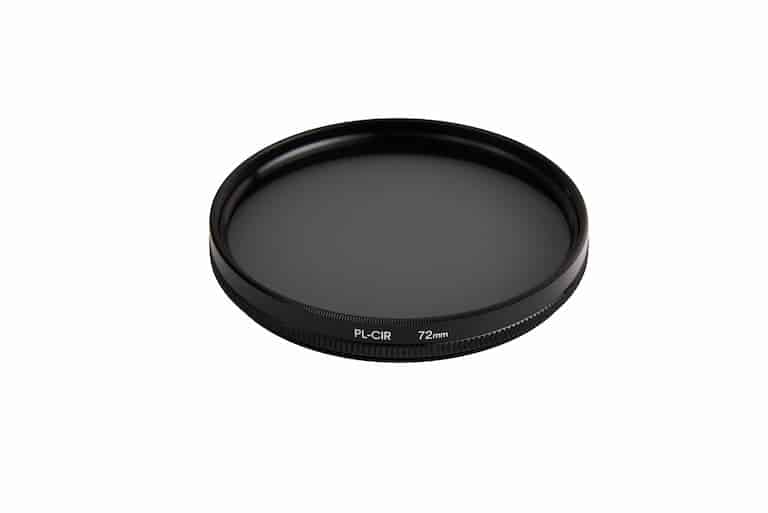
Pros and Cons of Using a Polarizer
The following table outlines some of the advantages and disadvantages of using a polarizer:
Pros
- Increases saturation.
- Improves contrast.
- Deepens the blues of the sky, which is especially important in landscape photography.
- Adds texture to photos.
- Counteracts the glare of sunlight.
- Allows you to see through shallow water.
Cons
- Can make the sky appear gradient depending on the position of the sun.
- Requires more time for setup.
- Circular polarizers require adjustment every time you change the frame.
- It can be difficult to see changes in the viewfinder.
- Reduce the amount of light entering your lens, reducing exposure time.
- High-quality filters are expensive.
- Can add ghosting.
- Can add vignetting.
- Can eliminate rainbows in images.
Even though there are some disadvantages to using a polarizer, the pros largely outweigh the cons.
How Other Lens Filters Compare
UV and polarizing filters are the most common and useful lens filters available, but they aren’t the only ones. Let’s take a look at some other types of lens filters. We’ll also give you a solid recommendation for each one, in case you think one of these will work better for you than UV filters and polarizers. All products mentioned here are available on Amazon.
Neutral Density Filters
These filters reduce the light that enters your lens without changing the color of the image. With neutral density filters, you can shoot at lower shutter speeds without overexposure. They are best for situations with excess sunlight or bright studio lights.
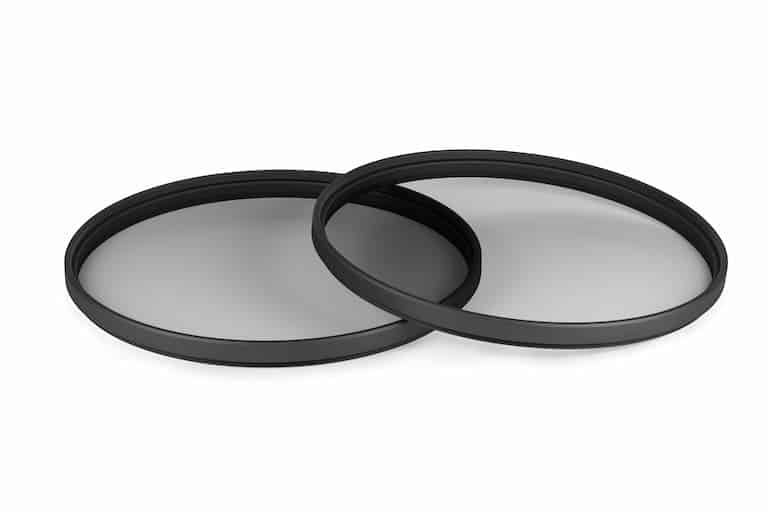
These filters are rated in stops of light. A 2-stop neutral density filter blocks a small amount of light, whereas a 10-stop neutral density filter blocks a lot of light. They work best for landscape, flash, and street photography.
The K&F Concept Ultra Slim Filter is made with professional optical glass, which is more durable than resin. The slim design helps prevent vignetting. This filter is also compatible with a wide range of lenses.
77mm Fader Ultra Slim Neutral Density Adjustable Lens Filter.
Graduated Neutral Density Filter
These filters have a gradual transition between dark and clear, which balances the exposure between a bright sky and a dark foreground. They are measured in stops, which indicates the stops of light that determine how much to darken a scene.
These come in three types:
- Soft-edged
- Hard-edged
- Reverse
The primary purpose of these lenses is to handle tricky lighting and circumstances where one part of the frame needs more exposure than the other. They are best for use in landscape photography and when taking pictures of sunrises and sunsets.
The Urth Soft Graduated Lens Filter is made with high-quality, 20-layer, nano-coated German glass, which provides supreme sharpness and color neutrality. It’s also backed with a lifetime guarantee.
Color Correcting Filters
You can use color-correcting filters to correct, change, or enhance the color of a scene, as the name suggests. These filters help colors in images appear more accurate and beautiful, reducing the amount of time spent on color correction in post-production.
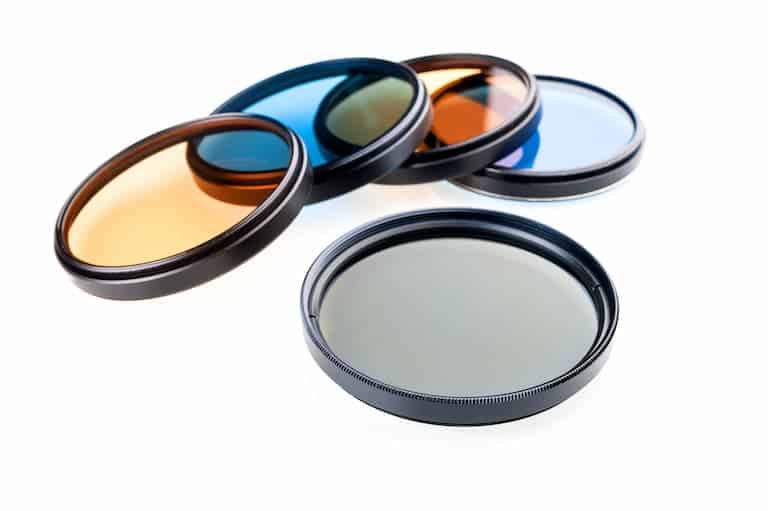
These lenses are best for situations when there isn’t a lot of natural light, so anytime a photographer is shooting indoors or in fluorescent lighting.
The Opteka HD Multicoated Filter Kit comes with nine filters in different colors that photographers can use to balance harsh indoor lighting or add an artistic effect. They are double-threaded, so you can use more than one filter at a time.
Fits Digital SLR Cameras. Includes the following colors: Red, Orange, Blue, Yellow, Green, Brown, Purple, Pink, and Gray ND Filters.
Close-up Filters
These filters allow photographers to take macro photos without a macro lens, which is especially helpful to novice photographers or those on a tight budget, as macro lenses can be extremely expensive.
These are used for close-up images to capture more detail and texture.
The Digital NC 10x HD Lens is compatible with high-speed autofocus and has an anti-reflection coating to prevent distracting and unattractive glare. Additionally, this lens is compatible with a wide range of lenses, including Nikon, Canon, Sony, Panasonic, Pentax, and Olympus.
Close-Up Lens Fits Nikon, Canon, Sony, Panasonic, Fujifilm, Pentax & Olympus DSLRs.
Starburst Filters
This special effects filter adds a twinkle effect to light sources, such as street lamps and Christmas lights. This filter is best for those who like a little whimsy in their images, especially street photographers.
This SX-SweetDream Starburst Lens Filter makes bright spots in photos have a star-shaped effect and is made with a metal sealing ring, which provides a more secure attachment. This filter also comes with a one-year warranty.
Compatible with 52mm 3-piece Star Filter. Usable on Canon, Nikon, Sony, Olympus, Pentax, Tarmon, Sigma, and Other DSLR Cameras (4 Points, 6 Points, and 8 Points).
Infrared Filters
An infrared filter is designed to block all light except infrared light, which can yield creative results. This kind of filter is best for photographers who want to try something new and fun.
The GREEN.L Infrared Filter is made with professional optical glass and resistant coating technology, which is resistant to scratches and environmental hazards. Furthermore, the frame is made of tough aluminum, so the filter is likely to last you a long time.
Conclusion
Both UV lens filters and polarizers absorb light to make the coloring of your picture more accurate. The difference is that UV filters only absorb UV light, whereas polarizers absorb all light, especially anything causing a glare.
The best filter for you depends on what you’re shooting and what you want the end product to look like.

